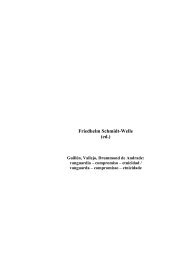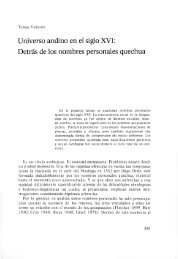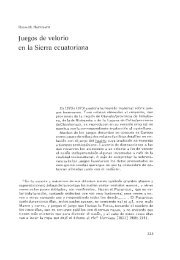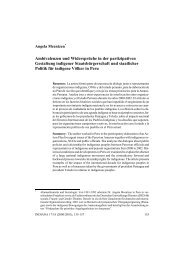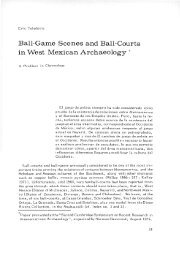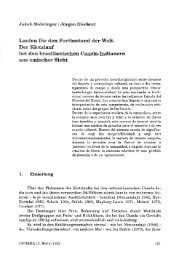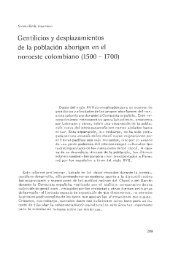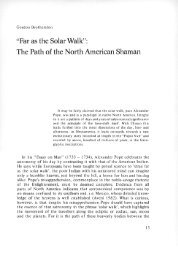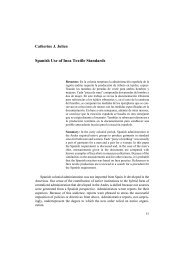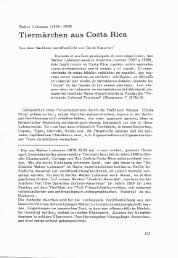Time and Script in Ancient Mesoamerica
Time and Script in Ancient Mesoamerica
Time and Script in Ancient Mesoamerica
Create successful ePaper yourself
Turn your PDF publications into a flip-book with our unique Google optimized e-Paper software.
Conquest Aztec documents at least, we f<strong>in</strong>d unequivocal confirmation of the<br />
primary importance of the year <strong>and</strong> the 52-year period for history, <strong>in</strong> un<strong>in</strong>terrupted<br />
rows <strong>and</strong> blocks of boxed signs to which <strong>in</strong>formation is attached<br />
only where appropriate, even <strong>in</strong> a 'space' which is otherwise more like that<br />
of a route map, <strong>in</strong> the Botur<strong>in</strong>i codex for example. In the post-Conquest<br />
v/orld, this particular use of the corpus of twenty signs was the one which<br />
more <strong>in</strong>terested Europeans, <strong>and</strong> those Indians who strove to adapt to new<br />
conventions <strong>and</strong> priorities. Conversely, it was precisely the mantic (priestly)<br />
use of the signs which fell <strong>in</strong>to oblivion, with the demise of those who<br />
possessed the esoteric knowledge necessary for underst<strong>and</strong><strong>in</strong>g them.<br />
This brief account does not pretend to do justice to all the apparent functions<br />
of the twenty signs, alone, <strong>in</strong> the Sacred Round or <strong>in</strong> the Calendar<br />
Round. The important po<strong>in</strong>t is the suggestion that the signs, with or without<br />
numerical co-efficients, may not be exclusively identified withour days even<br />
if they most often had that value <strong>in</strong> practice. For it is precisely the capacity<br />
to make that identification, <strong>in</strong>variably <strong>and</strong> universally, which dist<strong>in</strong>guishes<br />
the Long Count system.<br />
THE LONG COUNT<br />
The Long Count is generally said to have come <strong>in</strong>to be<strong>in</strong>g through a process<br />
of accretion, Satterthwaite speaks of it as a 'Proto-classic addition' to<br />
the Calendar Round (1965: 606). Week-like cycles or rounds are supposed<br />
to have comb<strong>in</strong>ed with those which made up the Calendar Round, to produce<br />
ever larger periods of time. True or not, this would still not account for<br />
the dist<strong>in</strong>ctive features of the Long Count <strong>in</strong> its <strong>Mesoamerica</strong>n context, Similarly<br />
Morley's rules (1915) may excellently <strong>in</strong>struct us how the Long Count<br />
worked, with its <strong>in</strong>tricate differences from our time count, without ourneed<strong>in</strong>g<br />
to realize the logical steps that must have been taken to produce that system,<br />
once aga<strong>in</strong> <strong>in</strong> its context. Part of our difficulty <strong>in</strong> treat<strong>in</strong>g it here is<br />
that even <strong>in</strong> the very first examples of its use all those steps appear to have<br />
been taken already.<br />
The fundamental fact about the Long Count is that it equates one day with<br />
one unit. From the first the fact is formally recorded by an encircl<strong>in</strong>g of the<br />
twenty signs to make 'counters' of them, each equivalent <strong>in</strong> value to the rest<br />
(fig. 6). The essence of the calendar becomes, then, not the year or the Calendar<br />
Round, but the day-unit. The encircl<strong>in</strong>g of the signs makes of them<br />
usable counters <strong>in</strong> the sense that they are complete, of completed time like<br />
our hours <strong>and</strong> m<strong>in</strong>utes, <strong>and</strong> dispensable with<strong>in</strong> arithmetical logic. Though<br />
their sequence rema<strong>in</strong>s the same, the encircl<strong>in</strong>g also circumscribes whatever<br />
mantic or other power each may possess, mak<strong>in</strong>g it accountable to a<br />
given astronomical event (a day) or conceptually, to itself, <strong>and</strong> not to the<br />
magic of the Sacred Round, for which no term is recognizable <strong>in</strong> Maya.<br />
The formula '1 day = 1 unit' was applied not just to the 260 comb<strong>in</strong>ations<br />
of the Sacred Round but to the 19 agricultural <strong>and</strong> ceremoniaí months of the<br />
18



